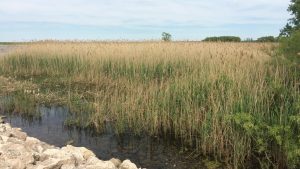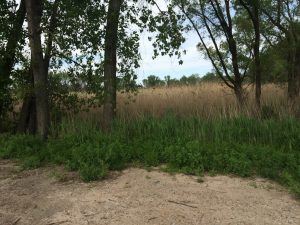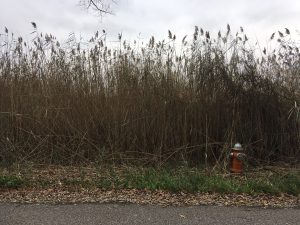February 7, 2019 – Samantha Stanton, Great Lakes Commission
How do Phragmites affect your life?
The impacts of non-native invasive Phragmites touches the lives of all people in the Great Lakes basin and beyond, even if they aren’t aware of their existence! To help us better think about the impact of Phragmites, we can break the impacts up into three categories: water, wildlife, and way of life.
Water

Phragmites is an aquatic invasive that can expand when water levels are low or hydrology in general is altered. Phragmites consumes a lot of water and has been documented lowering water levels in some wetlands. Its dense stems can also alter the flow of water and clog drainage ditches. Dense stands can also limit access to water for recreational purposes.
Wildlife

Phragmites is known to impact multiple wildlife species, from birds to threatened and endangered reptiles and amphibians. Large patches of Phragmites do not provide habitat for marsh-nesting bird species, and support fewer insects that are food for aerial foraging birds than native wetland plants. Wildlife organizations including the US Fish and Wildlife Service, Ducks Unlimited, the Nature Conservancy, etc. are actively engaged in Phragmites management to restore habitat for fish and wildlife populations.
Way of Life

Photo by Dan Engel, USGS
Phragmites can obstruct access to recreation areas (e.g., access to boat launches and fishing docks), block viewscapes (e.g., beach views), and pose a variety of safety hazards. The image above demonstrates one such hazard. Large stands of Phragmites can block right of ways and fire hydrants, become a fire hazard when the dried biomass accumulates, and interfere with structures such as building foundations and concert surfaces. Even more serious yet, dense Phragmites stands have resulted in loss of life when people become lost in dense stands in inclement weather.
Summary
The presence of invasive non-native Phragmites has negative impacts on more than just the flora and fauna of the habitat it invades. Humans and the ecosystem alike are impact by Phragmites. From hunters and fishers concerned about recreational opportunities, to urban residents with Phragmites invading their drainage ditches, everyone in the Great Lakes basin feels the impacts of this invasive species. If you identify a patch of non-native Phragmites on your property and do not know how to manage it, contact your local invasive species management group.
